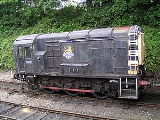
British Rail Class 10
Encyclopedia
The British Rail Class 10 diesel locomotive
was a variation on the Class 08
diesel-electric shunter
in which a Blackstone
diesel engine
was fitted instead of one made by the English Electric
company. Traction motors were by either the General Electric Company plc (GEC) or British Thomson-Houston
(BTH).
The locomotives were built at the BR Works in Darlington and Doncaster over the period 1953–1962. Early batches were classified D3/4 (those with GEC motors) and D3/5
(those with BTH motors).
Diesel locomotive
A diesel locomotive is a type of railroad locomotive in which the prime mover is a diesel engine, a reciprocating engine operating on the Diesel cycle as invented by Dr. Rudolf Diesel...
was a variation on the Class 08
British Rail Class 08
The British Rail Class 08 is a class of diesel-electric shunting locomotive. From 1953 to 1962, 996 locomotives were produced, making it the most numerous of all British locomotive classes....
diesel-electric shunter
Switcher
A switcher or shunter is a small railroad locomotive intended not for moving trains over long distances but rather for assembling trains ready for a road locomotive to take over, disassembling a train that has been...
in which a Blackstone
Blackstone & Co
Blackstone & Co. was a farm implement maker at Stamford, Lincolnshire, England. In 1896 they built lamp start oil engines. By 1912 they had developed a new diesel engine that ran on vaporizing oil and was fired by a spark...
diesel engine
Diesel engine
A diesel engine is an internal combustion engine that uses the heat of compression to initiate ignition to burn the fuel, which is injected into the combustion chamber...
was fitted instead of one made by the English Electric
English Electric
English Electric was a British industrial manufacturer. Founded in 1918, it initially specialised in industrial electric motors and transformers...
company. Traction motors were by either the General Electric Company plc (GEC) or British Thomson-Houston
British Thomson-Houston
British Thomson-Houston was a British engineering and heavy industrial company, based at Rugby, Warwickshire, England. They were known primarily for their electrical systems and steam turbines. They were merged with the similar Metropolitan-Vickers company in 1928, but the two maintained their own...
(BTH).
The locomotives were built at the BR Works in Darlington and Doncaster over the period 1953–1962. Early batches were classified D3/4 (those with GEC motors) and D3/5
British Rail Class D3/5
British Rail Class D3/5 was a shunting locomotive built by British Rail at their Darlington Works in England. It was a diesel powered locomotive in the pre-TOPS period and the class was numbered 13152–13166 ....
(those with BTH motors).
Technical details
- Engine: Blackstone 6-cylinder, 4-stroke, ER6T
- Traction motors:
- 2 x BTH motors (D3152–D3166)
- 2 x GEC nose suspended motors (remainder)
Preservation
Four Class 10 diesel shunters are currently preserved:- D3452 at Bodmin and Wenford RailwayBodmin and Wenford RailwayThe Bodmin & Wenford Railway is a heritage railway, based at Bodmin in Cornwall, United Kingdom. It has an interchange with the national rail network at Bodmin Parkway railway station, the southern terminus of the line.-History:...
- D3489 at Spa Valley RailwaySpa Valley RailwayThe Spa Valley Railway is a standard gauge heritage railway that runs between Tunbridge Wells, High Rocks, Groombridge, and Eridge railway station, where it links with the Oxted Line. En route it crosses the Kent and East Sussex border, a distance of 5 miles , along the former Three Bridges to...
- D4067 at Great Central Railway
- D4092 at Barrow Hill Engine ShedBarrow Hill Engine ShedBarrow Hill Roundhouse & Railway Centre, until 1948 known as Staveley Roundhouse & Train Centre, is a former Midland Railway roundhouse in Barrow Hill, near Staveley and Chesterfield, Derbyshire .-History:...
- A fifth example was stored on the Colne Valley RailwayColne Valley RailwayThe Colne Valley Railway is a heritage railway based at Castle Hedingham Station, near Halstead in Essex, England. The railway consists of a mile-long running line, with a fully reconstructed station, signal box and railway yard...
, though has since been scrapped.

